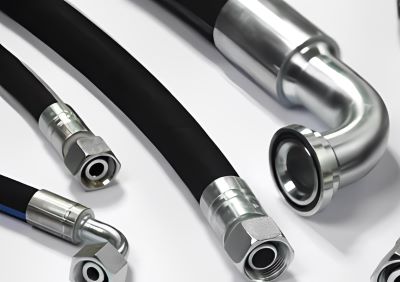Hydraulic systems are the workhorses of many industries, powering machinery and equipment with fluid pressure. While incredibly useful, safety is paramount when dealing with these powerful systems. One often-overlooked risk factor is the potential for electrical hazards. Standard hydraulic hoses can conduct electricity, posing a serious threat in specific situations.
This is where non-conductive hydraulic hose fittings come in, offering a crucial safety advantage.
Risks of Conductive Hydraulic Hose Fittings
Traditional hydraulic hose fittings often contain conductive materials like steel braid reinforcement. This can lead to several dangers:
➡️ Electrical shock hazards: Accidental contact with a charged hose due to stray current or grounding issues can result in serious injury or even death.
➡️ Arcing and sparks: In environments with flammable materials or gases, sparks from conductive hoses can ignite fires or explosions. This risk is particularly high during connection or disconnection of hoses.
These dangers are not merely theoretical. There have been documented incidents of fires and injuries caused by electrical arcing from hydraulic systems.
Benefits of Non Conductive Hydraulic Hose Fittings
Non-conductive hydraulic hose fittings are specifically designed to prevent these electrical hazards. Here’s how they benefit your operation:
➡️ Enhanced electrical safety: Made from non-conductive materials like nylon or thermoplastic, these fittings prevent electrical current from traveling through the hose. This significantly reduces the risk of shock for personnel working with the system.
➡️ Reduced risk of fire and explosions: By eliminating the possibility of sparks, non-conductive fittings offer an extra layer of protection in environments where flammable materials are present. This is crucial for industries like gasoline refining or chemical manufacturing.
➡️ Protection for sensitive equipment: Modern machinery often relies on delicate electronic components. Stray currents from conductive hoses can damage these components, leading to malfunctions and costly repairs. Non-conductive fittings safeguard these sensitive systems.
Applications of Non-Conductive Hydraulic Hose Fittings
Non-conductive hydraulic hose fittings are essential in various scenarios:
➡️ High voltage environments: Construction sites, mining operations, and utility work often involve working near power lines. Non-conductive fittings are vital to prevent accidental contact with high voltage.
➡️ Flammable materials handling: Industries dealing with gasoline, oil, or other flammable liquids require extra caution to prevent fires. Non-conductive fittings minimize the risk of sparks igniting these materials.
➡️ Sensitive equipment operation: Manufacturing facilities with robots, computer-controlled machinery, or medical equipment benefit from the protection non-conductive fittings offer against stray currents damaging electronics.
For example, consider crane operations near power lines. A standard hydraulic hose could potentially become charged if the crane makes accidental contact with a live wire. This situation is far less risky with non-conductive fittings, protecting both personnel and the equipment.
Choosing Non Conductive Hydraulic Hose Fittings
When selecting non-conductive hydraulic hose fittings, several factors come into play:
➡️ Material selection: Nylon and thermoplastic are common non-conductive materials, each with its own strengths and weaknesses. Consulting a hydraulics professional can help you choose the most suitable material for your application.
➡️ Compatibility with fluids: The type of hydraulic fluid used in your system needs to be compatible with the fitting material. Incompatible materials can degrade over time, leading to leaks and potential safety hazards.
➡️ Pressure and temperature ratings: Hydraulic systems operate under varying pressure and temperature conditions. Choose fittings with pressure and temperature ratings exceeding your system’s typical operating range for a safety margin.
➡️ Regulations and standards: Some industries have specific regulations regarding hydraulic hose fittings. The SAE J517 standard, for instance, outlines requirements for non-conductive hoses used in mobile equipment.
Conclusion
Prioritizing safety above everything else is crucial when dealing with hydraulic systems. Non-conductive hydraulic hose fittings offer a significant advantage by eliminating electrical hazards and protecting personnel, equipment, and surrounding environments.
When choosing these fittings, consider the specific needs of your application and consult with a qualified hydraulics professional for expert guidance. By prioritizing safety, you can ensure your hydraulic system operates smoothly and efficiently for years to come.
Post time: Jul-19-2024


